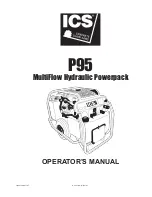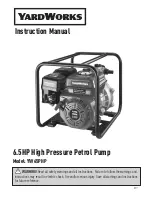
Model G0490W/G0490XW (Mfd. Since 5/16)
-37-
Symptom
Possible Cause
Possible Solution
Tables are hard to
adjust.
1. Table lock is engaged/partially engaged.
2. Table stops blocking movement.
1. Completely loosen table locks (
Page 3).
2. Loosen/reset table stop bolts (
Pages 46–47).
Excessive snipe
(gouge in end of
board that is uneven
with rest of cut).
1. Outfeed table is set too low, or knives
(straight knife cutterheads only) set too
high.
2. Operator pushing down on trailing end
(infeed side) of workpiece as it leaves
cutterhead.
1. Align outfeed table with cutterhead knives/inserts at
top dead center (
Page 46).
2. Focus most of the workpiece pressure against
outfeed table while cutting.
Workpiece stops in
middle of cut.
1. Outfeed table set too high.
1. Align outfeed table with cutterhead knives/inserts at
top dead center (
Page 27).
Workpiece
chipping, tear-out,
indentations, or
overall rough cuts.
1. Not feeding workpiece to cut "with" the
grain.
2. Dull knives/inserts.
3. Workpiece not suitable for jointing.
4. Nicked or chipped knives or inserts.
5. Feeding workpiece too fast.
6. Excessive depth of cut.
7. Lack of proper dust collection or clogged
dust port.
1. Turn the workpiece 180° before feeding again.
2. Sharpen/replace knives; rotate/replace insert(s)
(
Pages 38–41).
3. Ensure workpiece is suitable for jointing (
Page 27).
4. Replace knives (
Page 38); rotate/replace insert(s)
(
Page 41).
5. Reduce feed rate.
6. Reduce depth of cut.
7. Clear blockages, ensure dust collection is operating
efficiently; upgrade dust collector.
Fuzzy grain left in
workpiece.
1. Wood has high moisture content.
2. Dull knives/inserts.
1. Ensure wood moisture content is less than 20%.
Allow to dry if necessary.
2. Replace/rotate knives/inserts (
Pages 38–41).
Long lines or ridges
that run along the
length of the board
1. Nicked or chipped knives/inserts.
2. Loose or incorrectly installed insert (s).
3. Dirt or debris under carbide inserts (spiral
cutterheads only).
1. Replace/rotate knives/inserts (
Pages 38–41).
2. Remove/replace insert (s) and install properly (
Page
41).
3. Remove inserts, properly clean mounting pocket
and re-install (
Page 41).
Uneven cutter
marks, wavy
surface, or chatter
marks across face
of workpiece.
1. Feeding workpiece too fast.
2. Knives/inserts not adjusted at even heights
in the cutterhead.
3. Dirt or debris under carbide inserts (spiral
cutterheads only).
1. Reduce feed rate.
2. Adjust the knives so they are set up evenly in the
cutterhead (
Page 38). Remove, clean, and re-install
any inserts that are "raised" in the cutterhead (
Page
41).
3. Remove inserts, properly clean mounting pocket
and re-install (
Page 41).
Glossy surface;
scorching or burn
marks on workpiece.
1. Dull knives/inserts.
2. Feed rate too slow.
1. Sharpen/replace knives; rotate/replace insert(s)
(
Pages 38–41).
2. Increase feed rate.
Workpiece is
concave or convex
along its length after
jointing.
1. Workpiece not held with even pressure
against outfeed table during cut.
2. Workpiece too uneven at start of operation.
3. Tables are not parallel with cutterhead and
each other.
1. Apply even downward pressure against workpiece
throughout entire travel along outfeed side during
cut.
2. Take partial cuts to remove extreme high spots
before doing a full pass.
3. Check/adjust table parallelism (
Page 44).
Operations
Summary of Contents for G0490W
Page 64: ......
















































